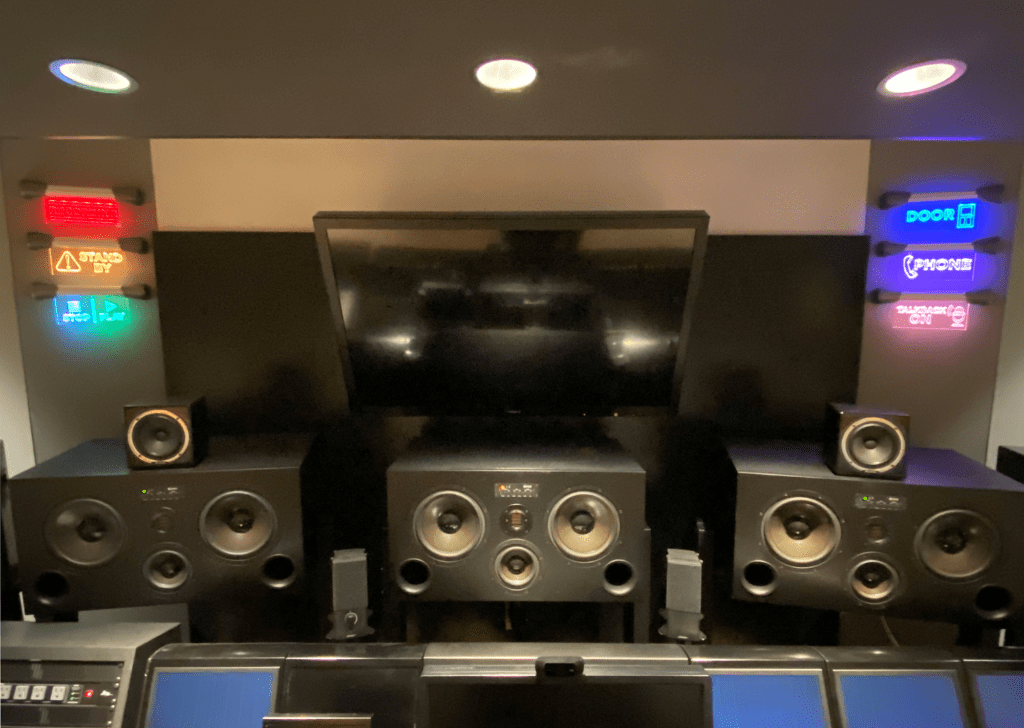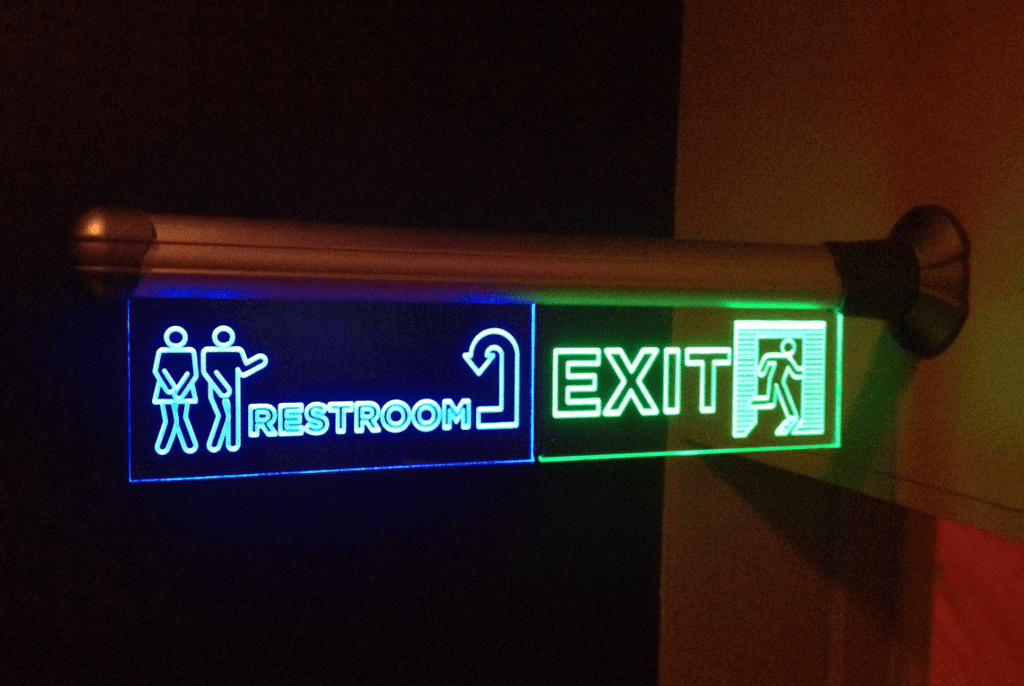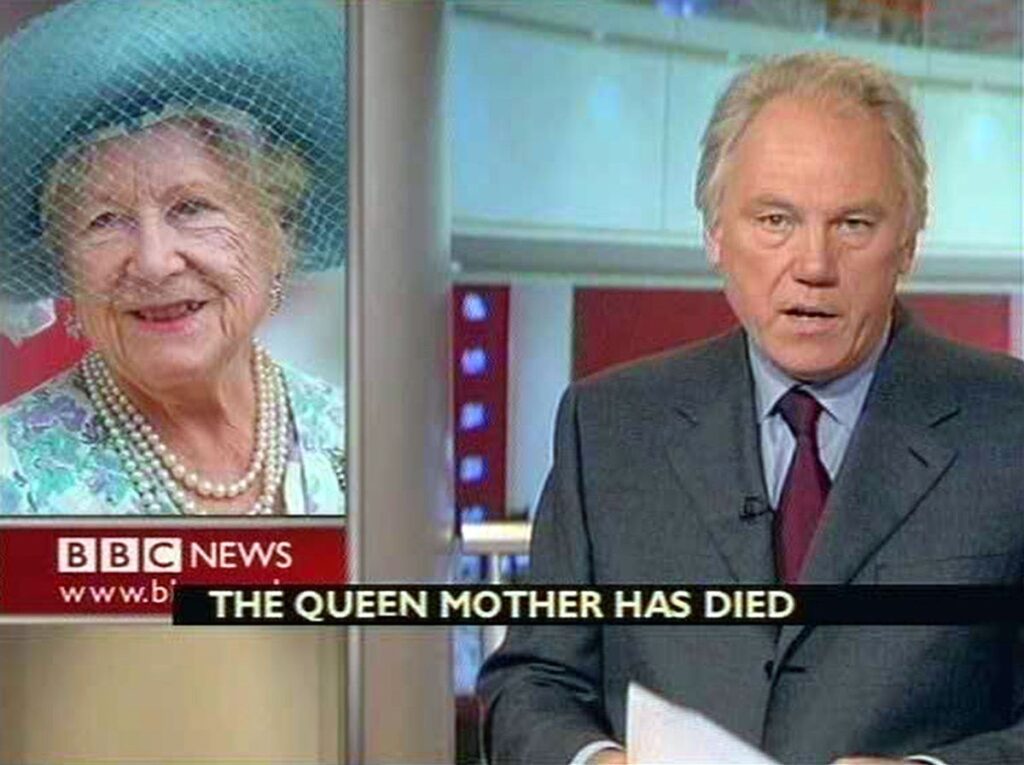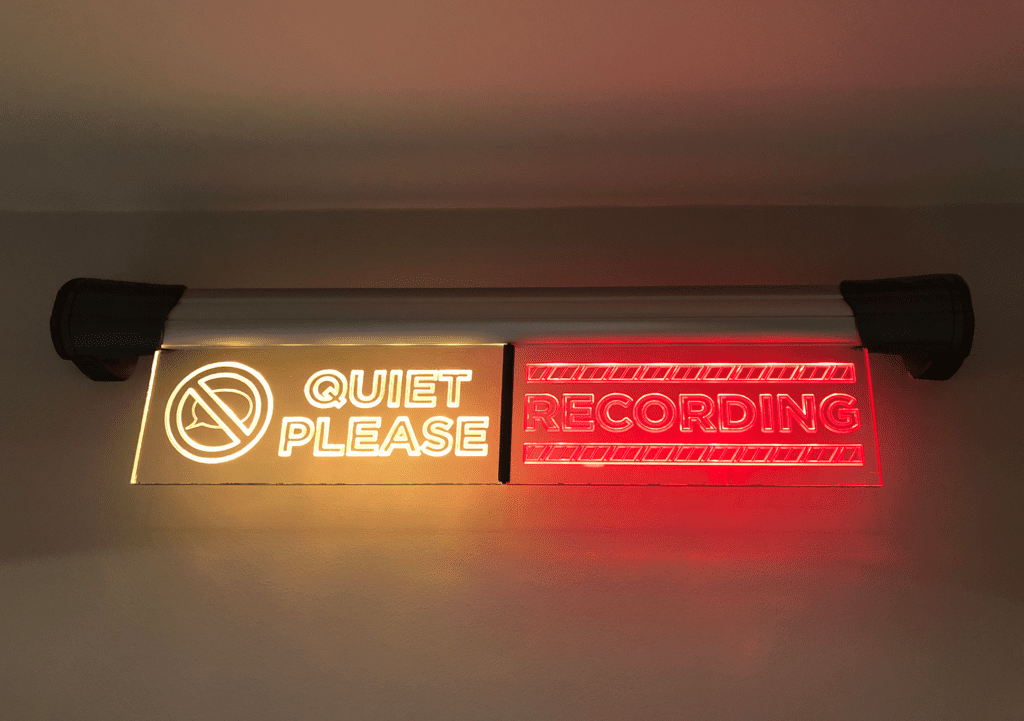When Her Majesty Queen Elizabeth II of the United Kingdom passed away back in September, it reminded me of a fascinating quirk about the radio and TV broadcasting industry in the UK — one we first learned about while I was designing the indicator light system here at ULS.
Any studio worth its salt — from the largest facility down to the smallest bedroom rig — needs to have some way of alerting both occupants and passers-by that recording is underway. Whether it’s a sign taped to the door, a bare bulb outside the control room, or any number of much more sophisticated signs and indicators offered by various studio equipment manufacturers, the goal is the same: warn passers-by to tread quietly, keep conversations down (or silent), and avoid bursting into the room when recording is taking place.
When I was considering what kind of signs we’d have in our studios, I came across UK-based manufacturer Sonifex, who build a variety of audio & video related products for professional studios and broadcasters. Their line of SignalLED signs are edge-lit signs that can be programmed to light up, in one of 16 different colors, in response to two different inputs.
Maybe you’d like a sign that says “QUIET PLEASE” in yellow when you’re getting ready to record, that then changes to red when you’re actually recording? With the Sonifex signs, that’s actually very easy and straightforward to do. You also have the option to divide the sign in half, so that one part says “STAND BY” and the other says “RECORDING”, and then light each part separately. It’s a very cool, clean solution for getting a lot of indicators right in front of your face. Our control room features seven different indicators, on six separate signs, giving us a good heads-up view of the state of the studio at any given moment. In total, we have 23 independently addressable indicators, spread across 14 Sonifex signs, around our facility.

As an added bonus, Sonifex will custom engrave signs for you if you wish. Their stock graphics are fine, but I liked the idea of injecting a bit of my own humor into the signs I’d see everyday around the facility.

So we went the custom route with Sonifex on all our signs. But it was interesting to note what sorts of signs and phrases Sonifex offer as part of their “stock” line of ready-to-order signs. Their standard catalog includes all sorts of unsurprising words and phrases — ON AIR, RECORD, PHONE, AD BREAK, REHEARSAL, MEETING IN PROGRESS, SILENCE — lots of useful visual indicators for any number of situations you might encounter in a studio facility where an alert needs to be seen, not heard.
But there is one sign — a regularly stocked, non-custom design, one that has an actual model number — that really had me scratching my head.

The OBIT sign.
OBIT? Was this some sort of an odd abbreviation for a common situation broadcasters deal with?
“On Break In Theater”?
“0 Bits” — as in, the digital transmitter has failed (no bits are being sent) and the station is off the air?
Or was that “Obituary”?
Why would a broadcaster need an obituary sign? And why would that be a common enough concern that you’d sell OBIT signs as a standard, stocked item?
Unfortunately, Sonifex includes very little explanation for what any of the abbreviations on their stock signs mean. I think they assume that if you’re there looking at their site, you probably already know what your facility’s needs are. You don’t need them to explain to you what any of this terminology means. It perhaps didn’t help matters that I was a US-based studio owner, when they are a UK manufacturer whose primary customers are UK-based broadcasters.
In any case, I forgot all about this little mystery for several years.
Then, a few years later, I was at the National Association of Broadcasters trade show in Las Vegas. In addition to broadcast-related technologies, these days the NAB Show really appeals to anyone who makes content of any sort — podcasters, audio engineers, and yes, private studio owners like me. Sonifex had a booth at the show that year. So I took the opportunity to introduce myself, mention how much we loved the look of our custom Sonifex signs here at ULS, and ask two burning questions — what does OBIT mean, and why do you sell OBIT signs as a standard item?
The answer lies at the intersection of a fascinating bit of UK broadcasting regulations and UK broadcasting traditions.
The OBIT sign, the Sonifex rep explained to me, does indeed signify “Obituary.” Its use in UK studios goes back many decades. The indicator is used to alert broadcasters that “a loss of life or death of a major figure” such as the monarch, other senior members of the royal family, or the then-current Prime Minister, has occurred. There is a very formal set of protocols, known as an OBIT procedure, that dictate everything from the way the television presenters should dress when announcing a royal death (in black), to the text of the actual announcement, to the content of the programs the broadcasters should switch to when cutting away from their regularly scheduled shows.

On the radio side, UK national news broadcaster Independent Radio News (IRN) is the entity that transmits the notifications and official announcement to local stations around the country and the UK Commonwealth. Stations must install equipment in their facilities that alerts the staff that a senior member of the royal family or other important national leader has died. Part of that system includes — yes, an OBIT light. The light serves as a heads-up that IRN will be transmitting an official announcement shortly. It’s not a light anyone likes to see, obviously, because it means the country is about to enter a time of national mourning. So, yes, the Sonifex representative explained to me…”OBIT” means exactly what you think it means. And an OBIT sign is standard equipment in studios all across the United Kingdom.
[blockquote]I suppose the closest analog we’d have to this sort of an alert system in the U.S. is the “Emergency Alert System”, and its predecessor, the Emergency Broadcast System. US broadcasters carry equipment that automatically listens for coded alert signals warning of imminent danger or emergencies. But to my knowledge, these systems have never been used to announce the deaths of important people — even ones important enough to warrant interruptions of normal radio and television programming.
If you’re of a certain age and listened to US radio with any regularity, you will likely remember the “EBS Test” messages that stations were required to conduct periodically. “This is a test…this station is conducting a test of the Emergency Broadcasting System…this is only a test…”, followed by a dissonant, 20 second, two-tone “Attention Signal”. We were then told “if this had been an actual emergency, the Attention Signal you just heard would have been followed by official information, news, or instructions.” Test or not, those messages always scared the beejeezus out of me when I was 9 years old.[/blockquote]
With that mystery solved, I thanked the Sonifex guys for talking to me, went on my way, and completely forgot that I’d ever wondered about this little oddity in Sonifex’s catalog.
Then, when Queen Elizabeth passed in September, I remembered what I’d learned about the OBIT sign. It was interesting to discover, when researching this post, that although I hadn’t been able to find any explanation of the OBIT sign when I went looking back in 2011, it turns out that since 2017 there have been several articles about the existence of the “OBIT protocol” and the procedures it entails.
In 2017, when the Queen turned 90, British newspaper The Guardian published a long article about the remarkable level of planning already underway for every aspect of the Queen’s eventual death and the ensuing succession. New York Magazine specifically looked at how the Queen’s passing would be handled by Britain’s radio and TV broadcasters. Another article appeared in 2021, when the Queen’s husband HRH Prince Phillip passed away, and another, this year, after her death. Each article mentions the “OBIT Procedure” and the presence of “flashing OBIT lights” in studios all over the UK when the Queen’s time finally came.
So there you have it — what started out as a simple search for some good looking RECORD lights led to a fascinating peek into how UK broadcasters receive news of a national tragedy. And thanks again to the Sonifex team for clearing up that mystery.
Share this:
- Click to email a link to a friend (Opens in new window) Email
- Click to share on X (Opens in new window) X
- Click to share on Facebook (Opens in new window) Facebook
- Click to share on LinkedIn (Opens in new window) LinkedIn
- Click to share on Pinterest (Opens in new window) Pinterest
- Click to print (Opens in new window) Print


